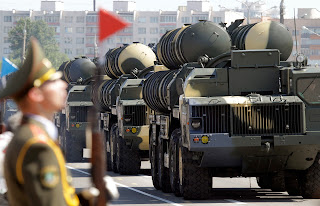The S-300 is a series of initially Soviet and later Russian long range surface-to-air missile systems produced by NPO Almaz, based on the initial S-300P version. The S-300 system was developed to defend against aircraft and cruise missiles for the Soviet Air Defence Forces. Subsequent variations were developed to intercept ballistic missiles. The S-300 system was first deployed by the Soviet Union in 1979, designed for the air defence of large industrial and administrative facilities, military bases and control of airspace against enemy strike aircraft. The system is fully automated, though manual observation and operation are also possible. Components may be near the central command post, or as distant as 40 km. Each radar provides target designation for the central command post. The command post compares the data received from the targeting radars up to 80 km apart, filtering false targets, a difficult task at such great distances. The central command post features both active and passive target detection modes.
The project-managing developer of the S-300 is Almaz-Antey. S-300 uses missiles developed by both MKB "Fakel" and NPO Novator design bureaus (separate government corporations, previously named "OKB-2" and "OKB-8").
The S-300 is regarded as one of the most potent anti-aircraft missile systems currently fielded. An evolved version of the S-300 system is the S-400 (NATO reporting name SA-21 Growler), which entered limited service in 2004.
An important quality of all complexes of the family of S-300 is the ability to work in various combinations within a single modification and within the same complex, between the modifications (limited), as well as through a variety of mobile superior command posts to line up in a battery of any composition, quantity, modifications, location and so on including the introduction of other air defence systems into a common battery. the System for the defence of the major industrial and administrative objects, military bases and control points from the shock means of air-space attack of the enemy. Capable of hitting ballistic and aerodynamic targets. Became the first multi-channel anti-aircraft missile system, is able to accompany each system (ADMS) to 6 goals and build them up to 12 missiles. When creating funds management (FM), consisting of paragraph combat control and radar detection, solved the problem of automatic track initiation of up to one hundred goals and effective management divisions, located at a distance of 30–40 km from the (FM).
For the first time established a system with full automation of combat operation. All tasks—detection, tracking, target setting is considered, target designation, development of target designation, target acquisition, maintenance, capture, tracking and missile guidance, assessment of results of firing system capable of dealing automatically with the help of digital computing facilities. The operator functions are to control over the work of funds and implementation of the launch of rockets. In a complex environment, you can manually intervene in the course of combat operation. None of the previous systems possessed these qualities. Vertical launch missiles provided bombardment of targets flying from any direction without the reversal of the launcher in the direction of the shooting. More details
The project-managing developer of the S-300 is Almaz-Antey. S-300 uses missiles developed by both MKB "Fakel" and NPO Novator design bureaus (separate government corporations, previously named "OKB-2" and "OKB-8").
The S-300 is regarded as one of the most potent anti-aircraft missile systems currently fielded. An evolved version of the S-300 system is the S-400 (NATO reporting name SA-21 Growler), which entered limited service in 2004.
An important quality of all complexes of the family of S-300 is the ability to work in various combinations within a single modification and within the same complex, between the modifications (limited), as well as through a variety of mobile superior command posts to line up in a battery of any composition, quantity, modifications, location and so on including the introduction of other air defence systems into a common battery. the System for the defence of the major industrial and administrative objects, military bases and control points from the shock means of air-space attack of the enemy. Capable of hitting ballistic and aerodynamic targets. Became the first multi-channel anti-aircraft missile system, is able to accompany each system (ADMS) to 6 goals and build them up to 12 missiles. When creating funds management (FM), consisting of paragraph combat control and radar detection, solved the problem of automatic track initiation of up to one hundred goals and effective management divisions, located at a distance of 30–40 km from the (FM).
For the first time established a system with full automation of combat operation. All tasks—detection, tracking, target setting is considered, target designation, development of target designation, target acquisition, maintenance, capture, tracking and missile guidance, assessment of results of firing system capable of dealing automatically with the help of digital computing facilities. The operator functions are to control over the work of funds and implementation of the launch of rockets. In a complex environment, you can manually intervene in the course of combat operation. None of the previous systems possessed these qualities. Vertical launch missiles provided bombardment of targets flying from any direction without the reversal of the launcher in the direction of the shooting. More details

